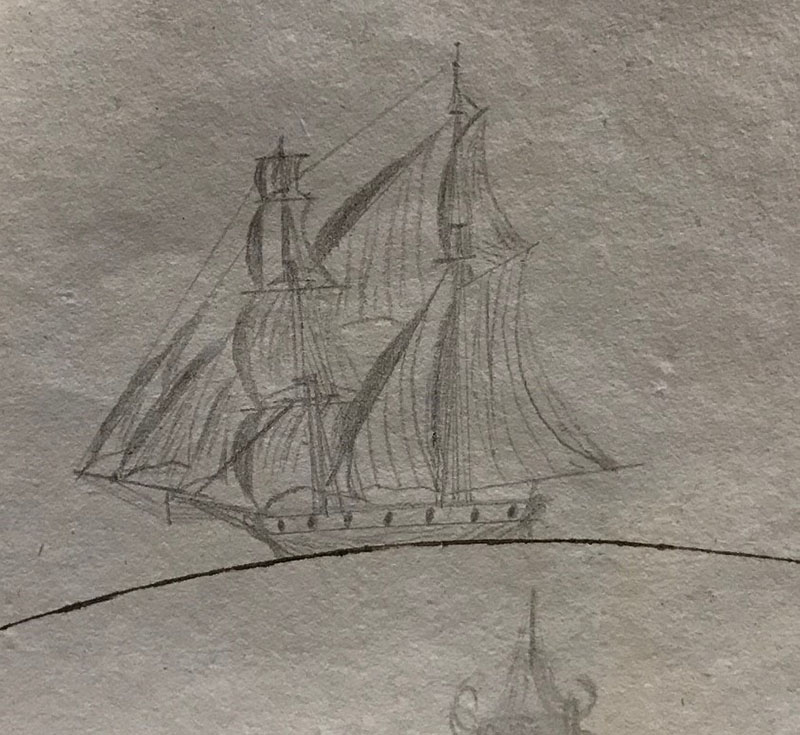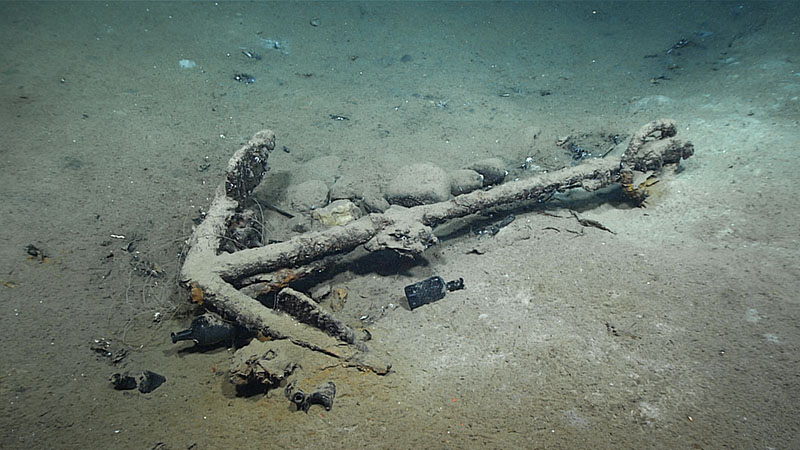2022 ROV and Mapping Shakedown
February 23 - March 3, 2022
Proving a Discovery: The Case for Industry
On February 25, 2022, NOAA Ocean Exploration and partners from SEARCH Inc. and the Bureau of Ocean Energy Management discovered the remains of what is likely the brig Industry. The article below describes how the research team came to their conclusion.
How do you identify a shipwreck when there’s little visual evidence of the ship that sank, and nothing with a ship’s name on it – like the bell? Like detectives, you look at all evidence and see if patterns – and a potential identity – emerge. We did this for the Shipwreck 15563 in the Gulf of Mexico, over a period of months that involved underwater footage of the wreck and extensive archival research. After a careful examination of the wreck site, which included hours of survey using a remotely operated vehicle (ROV) to inspect and film every visible artifact and feature, and a comprehensive survey that created a 3D visual “map” of the entire wreck site, key aspects about the wreck have emerged.
Based on the existing data, the evidence suggests that Shipwreck 15563 is a whaling ship lost in the Gulf while whaling within the first half of the 19th century. Decades of historical research has identified only one whaling ship that was lost while in service as a whaler in the Gulf: the brig Industry of Westport, Massachusetts.
Industry was a veteran whaler, entering the field in 1816. It was built at Westport in 1815 by master carpenter Isaac Cory, Jr., son of the brig’s owner, Isaac Cory, Sr. The ship was a single-decked, two-masted brig. Its dimensions were approximately 64 feet in length with a 20-foot beam and an 8.5-foot depth of hold. A registered tonnage of 94.3 tons was indicative of the ship’s small size.

Data collected from Shipwreck 15563 is consistent with what we have learned about Industry through our extensive research.
- The wreck’s hull form, the sole use of iron fasteners, fittings for cable (rope) for the anchors, an older style of anchors, and the rigging that held the masts in place are consistent with a ship of the first quarter of the 19th century, like Industry.
- The wreck is the same size as Industry.
- The wreck’s hull form is consistent with a ship with small tonnage like Industry.
- The wreck is that of a two-masted ship. Industry was a two-masted brig.
- The wreck shows no evidence of copper sheathing to protect the hull. Industry was not copper sheathed, and its logbooks and newspaper references often refer to its “leaky” nature as a result of marine organisms eating its unprotected hull.
- The wreck is 83 miles from where Industry, still adrift and water logged after a storm in May 1836, was boarded by the crew of the whaler Harmony of Nantucket, Massachusetts, on June 3, 1836.
- The wreck lies on the seabed north-northeast of the last recorded location of Industry. This is consistent with the ultimate sinking of a drifting, gradually flooding ship kept afloat only by the cargo of whale oil and pushed along by the loop current in this part of the Gulf.
- The wreck is strikingly empty; many other wrecks found in the Gulf in deep water are filled with artifacts. This wreck is missing an anchor and has few visible portable artifacts. Documented artifacts include the outline of a cask in the silt, two anchors, an iron “camboose” or stove, and bottles. Harmony’s captain reported that after his crew had pumped out or “freed” Industry, they “took off 230 bbls. [barrels] oil, part of sails and rigging, chain cable and anchor.” There is very little silt covering the wreck, so it is likely that the lack of artifacts is due to salvaging and not burial.
- The wreck’s camboose is not laid out as a regular stove; it has the layout of a whaling tryworks used to render whale fat into oil by extended, high-temperature boiling. In addition, it is surrounded by bricks that would have insulated the deck around it, an indication of intense, prolonged heat. Cambooses on other wrecks are configured differently, with lead sheets nailed to the deck. The unique configuration of this wreck’s camboose is a key piece of evidence that it is likely the wreck of a small whaling ship. Records indicate Industry was fitted with an iron camboose in 1827.
- Finally, out of 214 documented whaling voyages into the Gulf of Mexico between the late 18th and late 19th centuries, only one ended in shipwreck and loss in the Gulf of Mexico. That was Industry’s last voyage in 1836.


While a definitive identification cannot be made without seeing the ship’s name or other identifying features among the remains, we can confidently say that Shipwreck 15563 and Industry are likely one and the same.
Related Links
- Industry’s Place in U.S. History: The Maritime Legacy of African-American and Indigenous Peoples
- Setting the Stage for Discovery: Whaling in the Gulf of Mexico
- NOAA, Partners Discover Wreck of 207-Year-Old Whaling Ship in Gulf of Mexico
- Industry (BOEM Wreck Site 15563) Photogrammetry Model
Published March 23, 2022
Contributed by: James P. Delgado, SEARCH Inc.
Michael Brennan, SEARCH, Inc.
Scott Sorset, Bureau for Ocean Energy Management
Relevant Expedition: 2022 ROV and Mapping Shakedown